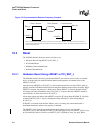
Hardware Reference Manual 361
Intel
®
IXP2800 Network Processor
Clocks and Reset
The fast frequency on the IXP2800 Network Processor is generated by an on-chip PLL that
multiplies a reference frequency provided by an on-board LVDS oscillator (frequency 100 MHz)
by a selectable multiplier. The multiplier is selected by using external strap pins SP_AD[5:0] and
can be viewed by software via the STRAP_OPTIONS[CFG_PLL_MULT] CAP CSR register bits.
The multiplier range is even multiples between 16 and 48, so the PLL can generate a 1.6 GHz to
4.8 GHz clock (with a 100-Mhz reference frequency).
The PLL output frequency is divided by 2 to get the Microengine clock and by 4 to get the Intel
XScale
®
core and the internal Command/Push/Pull bus frequency. An additional division (after the
divide by 2) is used to generate the clock frequencies for the other internal units. The divisors are
programmable via the CLOCK_CONTROL CSR. APB divisor specified in the
CLOCK_CONTROL CSR clock is scaled by 4 (i.e., a value of 2 in the CSR selects a divisor of 8).
Table 148 shows the frequencies that are available based on a 100-Mhz oscillator and various
values of PLL multipliers, for the supported divisor values of 3 to 15.
SRAM
SRAM pins and control logic (all of
the SRAM unit except Internal Bus
interface).
Divide of Microengine frequency. Each SRAM channel
has its own frequency selection. Clocks are driven by
the IXP2800 Network Processor to external SRAMs
and/or Coprocessors.
Scratch,
Hash, CSR
Scratch RAM, Hash Unit, CSR
access block
1/2 of Microengine frequency. Note that Slowport has
no clock. Timing for Slowport accesses is defined in
Slowport registers.
MSF
Receive and Transmit pins and
control logic.
The transmit clock for the Media and Switch interface
can be derived in two different ways.
• From TCLK input signal (supplied by PHY device).
• Divided from internal clock.
For details please refer to Chapter 8, “Media and
Switch Fabric Interface”.
APB APB logic Divide of Microengine frequency.
PCI PCI pins and control logic.
External reference. Either from Host system or on-
board oscillator.
Table 147. Clock Usage Summary (Sheet 2 of 2)
Unit Name Description Comment


















